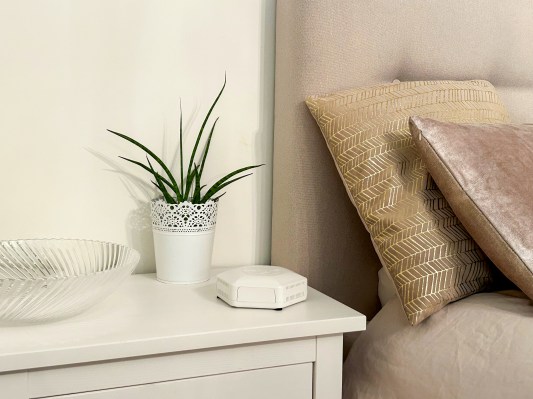W
elcome to the TechCrunch Exchange, a weekly startups-and-markets newsletter. It’s inspired by the daily TechCrunch+ column where it gets its name. Want it in your inbox every Saturday? Sign up here.
There was a lot going on in tech this week, and not just CES. But yes, CES was definitely worth watching closely, if only just for the rise of age tech. — Anna
Better aging
Following CES from a distance this year, I couldn’t help but notice how age tech, or silver tech, companies seemed to be in the spotlight — perhaps more than we expected.
For instance, I read that Microsoft CEO Satya Nadella had visited the booth of AgeTech Collaborative, an initiative from U.S. senior advocacy group AARP to showcase “groundbreaking age tech innovations” during the event.
The robot that Nadella met there is one I’ve met, too: ElliQ, an AI-enabled companion for older adults. Its parent company, Intuition Robotics, recently gave it an upgrade; nicknamed ElliQ 3, “the latest version of the robot features design tweaks, more powerful hardware and — of course — generative AI integration,” my colleague Brian Heater reported.
It’s not just at the AARP booth where age tech is on display, and the trend is global. There’s Tack One, from Singapore, with its location tracker for children and seniors. And there are at least three companies — Safe-Living, Serenity and Zoe Care — applying different approaches to the same problem: keeping older people safe by detecting falls.
I met Safe-Living CEO Sandro Cilurzo at TechCrunch Disrupt last year and was quite impressed by the demo that he showed me. (This isn’t just a figment of his imagination; the company’s device and app are already very much in use by B2B and B2C customers in Switzerland.)
Since avoiding false alarms is critical, Safe-Living’s technology is fine-tuned to know that a senior may be lying on the ground for their weekly yoga session, for instance. On the other hand, it may raise the alarm if that same person can’t get out of bed in the morning; beyond falls, it is focused on detecting helplessness situations.
CES 2024 marks Safe-Living’s second participation under the Swiss flag, and Cilurzo saw more inbound interest for age tech this time around. Compared to 2023, he received more meeting requests from associations and individuals scouting for solutions related to caregiving.
It could be because Safe-Living has been on an upward trajectory, too. Since Disrupt, Cilurzo landed his first U.S. B2B customer and is gearing up to launch its B2C offering there in the spring under a new brand called helpany. But there’s more, with a broad range of companies enjoying tailwinds.
“Age tech definitely feels some momentum, but more importantly, the momentum seems to be stemming from the industry itself. It is clearly perceivable that advanced technological solutions seem to be embraced more and more by the healthcare industry. The perception has shifted from “gadgets to a massive opportunity of value-add,” Cilurzo told me in an email.
Of course, it doesn’t hurt, either, when you can surf the AI hype as well. “Using AI is definitely helping us this year, more than in 2023,” Cilurzo said when we hopped on a call. But unlike some weird AI-enabled gadgets on showcase at CES, Safe-Living has been using AI since the very beginning and with an equally real use case. The more it happens, the better for CES and for everyone else.
Venture debt back in fashion?
Not everyone is fond of venture debt. The panelists of a roundtable I moderated at TechCrunch Disrupt last year certainly weren’t. For instance, Hadrian CEO Chris Power shared a warning with the many founders in the audience: “Unless you’re in real trouble, I would avoid venture debt at almost all costs.”
Well, startup finance company Arc Technologies still believes in the value prop of venture debt, especially in current times.
As my colleague Christine Hall reported, its Arc Capital Markets venture debt marketplace will help companies “receive indicative debt terms for up to $250 million within five days from a network of lenders” — saving them time and money.
“We want to help founders and CFOs weather the ongoing storm in the venture capital funding route and ensure that they’re continuing to grow efficiently with minimal dilution,” CEO Don Muir told Christine.
AI reshaping biotech
DeepMind’s AI-enabled drug discovery spinout Isomorphic Labs signed partnerships potentially worth $3 billion with Eli Lilly and Novartis, my colleague Kyle Wiggers reported.
Having discussed with Israeli fund Grove Ventures how there might be more than one winner in AI-enabled drug discovery, I knew general partner Renana Ashkenazi wouldn’t see this as bad news for Grove’s portfolio. Instead, she gave me more context as to why Eli Lilly and Novartis were keen to partner with Isomorphic.
“AI is really starting to reshape the biotech industry,” Ashkenazi said.
“Innovation and progress towards a detailed model of human cells, combined with the fact that big pharma’s returns on R&D are not as good as they used to be, create a unique market opportunity. In the near future, we will see more big pharma companies increasing AI-driven drug discovery and development activities,” she predicted.
Mixed reality
When I wrote last week about the (re)emergence of the metaverse, we didn’t know when the Apple Vision Pro headset would be available. It now has a U.S. launch date: February 2. But preorders start earlier — on January 19 at 5 a.m. PT. — so that may be the date you want to save . . . if you can afford the $3,500 price tag.
